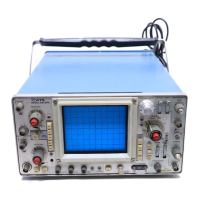TM 11-6625-2735-14-1
If values less than these are obtained, either the device
is short-circuited or no current is flowing in the circuit. If
values are in excess of the base-emitter values given, the
junction is back-biased or the device is defective. Values in
excess of those given for emitter-collector could indicate
either a non-saturated device operating normally, or a
defective (open-circuited) transistor. If the device is
conducting, voltage will be developed across resistances
in series with it; if it is open, no voltage will be developed
across resistances in series with it unless current is being
supplied by a parallel path.
When troubleshooting field-effect transistors, the
voltage across its elements can be checked in the same
manner as transistors. However, it should be remembered
that usual operation has the gate-to-source junction
reverse biased, or
0 biased, as is used in many circuits in
the 475.
IC’s (integrated circuits) can be checked with a
voltmeter, test oscilloscope, or by direct substitution. A
good understanding of circuit operation is essential to
troubleshooting circuits using IC’s. Use care when check-
ing voltages and waveforms around the IC’s so that
adjacent leads are not shorted together. A convenient
means of clipping a test probe to the 14- and 16-pin IC’s is
with an IC test clip. This device also doubles as an
extraction tool. The lead configuration for the semicon-
ductors used in this instrument are shown on Fig. 4-3.
b. DIODES. A diode can be checked for an open or
shorted condition by measuring the resistance between
terminals after disconnecting one end from the circuit.
With an ohmmeter set to the R X 1 k scale, the resistance
should be very high in one direction and very low when the
leads are reversed.
Do not measure funnel diodes with an ohmmeter;
use a dynarnlc tester (such as a Tekfronix Type 576
Transisfor-Curve Tracer).
Voltmeter checks on diodes can be performed in much
the same manner as on transistor emitter-to-base junc-
tions. Silicon diodes should have
0.6 to 0.8 volts across the
junction when conducting. Higher readings indicate that
they are either back biased or defective, depending on
polarity.
c. RESISTORS. Check the resistors with an ohmmeter
after disconnecting one end from the circuit. Check the
Electrical Parts List for the tolerance of the resistors used
in this Instrument. Resistors normally do not need to be
replaced unless the measured value varies widely from the
specified value.
d. INDUCTORS. Check for open inductors by check-
ing continuity with an ohmmeter. (It may be helpful to
disconnect one end of the inductor when checking
continuity.) Shorted or partially shorted inductors can
also be found by checking the waveform response when
high-frequency signals are passed through the circuit.
Partial shorting often reduces high-frequency response
(increases roll-off).
e. CAPACITORS. A leaky or shorted capacitor can be
detected by checking resistance with an ohmmeter, on the
highest scale, after disconnecting one end from the
circuit. Do not exceed the voltage rating of the capacitor
(some ohmmeters use 30 volts as source voltage). The
resistance reading should be high after initial charge of
the capacitor. An open capacitor can also be detected with
a capacitance meter or by checking whether the capacitor
passes ac signals.
f. ATTENUATORS. The thick film attenuators are best
checked by substitution. If only one channel of the 475 is
not operating properly, and there is reason to believe an
attenuator is defective, replace the suspected attenuator
with the same attenuator from the other channel and
check instrument operation. If proper operation results,
order a new attenuator. (See Component Replacement for
replacement instructions.)
10. Repair and Readjust the Circuit. If any defective
parts are located, follow the replacement procedures
given in this section. Be sure to check the performance of
any circuit that has been repaired or that has had any
electrical components replaced. Recallbration of the
affected circuit may be necessary.
Special Troubleshooting Information
General.
The following
information provides a
procedure for troubleshooting some of the more complex
circuits in the 475. A thorough understanding of the circuit
operation is essential before troubleshooting in these
areas. Read the applicable portions of the Circuit Descrip -
tion in Section 3 before proceeding. This troubleshooting
procedure refers to the diagrams operating voltages and
waveforms given
in Section 8. Specifications for the
equipment necessary to troubleshoot in these procedures
are given earlier in this section under Troubleshooting
Equipment.
4-14

